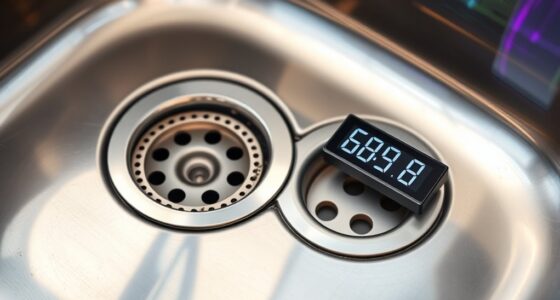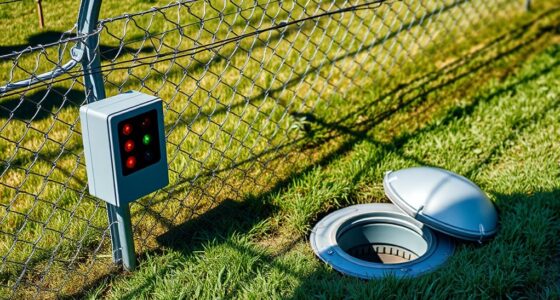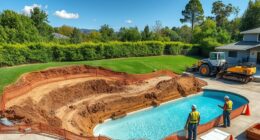Drain entrapment can happen when powerful suction pulls body parts, jewelry, or clothing into a pool or spa drain, especially if covers are broken or loose. You can prevent accidents by installing proper safety devices, maintaining and inspecting drain covers regularly, and following safety regulations. Recognizing high-risk features helps you stay alert. To protect yourself and others, learn about different prevention tools and safety protocols—more tips ahead will help you create a safer environment.
Key Takeaways
- Drain entrapment occurs when powerful suction pulls body parts or jewelry into pool or spa drains.
- Properly secured, maintained drain covers and safety devices can prevent entrapment incidents.
- Regular inspections and adherence to safety standards reduce risks of damaged or dislodged drain covers.
- Recognizing high-risk features like unprotected or complex plumbing setups helps prevent accidents.
- Emergency preparedness and technological safety advancements significantly lower the danger of drain entrapment.
What Is Drain Entrapment and How Does It Occur?

Drain entrapment happens when a person becomes stuck or caught in a drain or plumbing fixture, often during swimming or bathing. This occurs when body parts, clothing, or jewelry get caught in the openings or grates of drains, especially those with powerful suction. It’s common in pools, spas, and showers where drains are designed to remove water quickly. When you’re in the water, a loose piece of jewelry or clothing can slip into the drain opening, creating a suction force that pulls you in. If the drain’s cover isn’t secure or is damaged, it becomes easier for someone to become trapped. Without proper safety measures, this situation can become dangerous, leading to injuries or even drowning.
Common Causes of Drain Entrapment Incidents
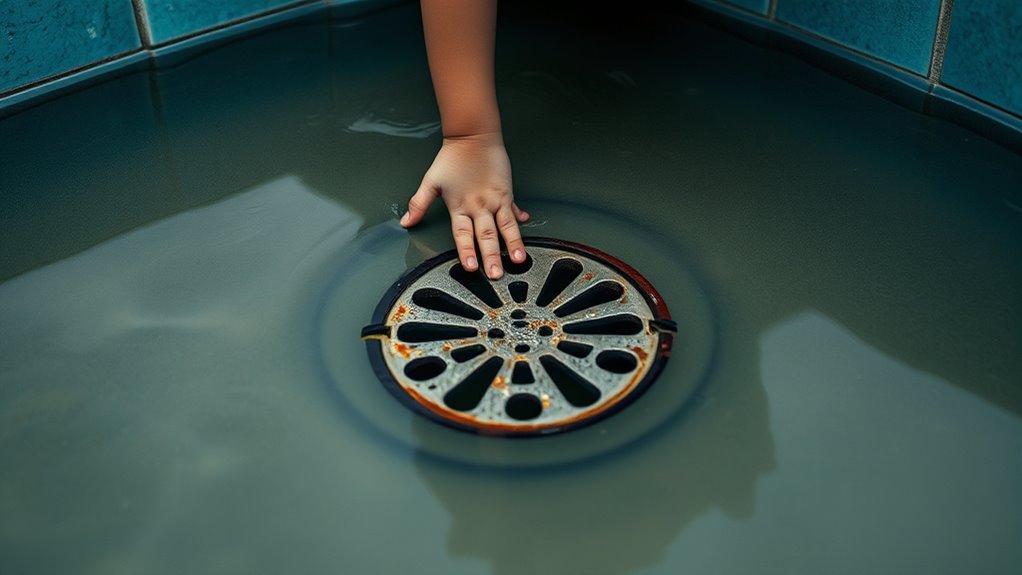
Many drain entrapment incidents happen because of improper drain cover use or missing safety barriers. When covers are broken or not secured properly, it increases the risk of someone getting caught. Additionally, the absence of barriers around drains can make it easier for accidents to occur. Implementing appropriate safety measures can significantly reduce these risks.
Improper Drain Cover Use
When improper drain cover use occurs, it substantially increases the risk of entrapment incidents. If covers are loose, damaged, or not securely fastened, they can break or shift under pressure, exposing the opening. Using covers that don’t meet safety standards or are designed for different types of drains also creates hazards. For example, a cover that’s too small or has gaps can trap hair, jewelry, or body parts. Over time, poor installation or maintenance can weaken the cover’s integrity, making it more likely to fail during use. Always verify drain covers are properly rated for the specific application, fit securely, and are regularly inspected for damage. Proper use and maintenance of drain covers are essential steps in preventing entrapment. Regular inspection and safety standards compliance further reduce the risk of accidents.
Lack of Safety Barriers
Lack of safety barriers around drains considerably increases the risk of entrapment incidents. Without barriers, swimmers and bathers may accidentally get too close or slip into dangerous positions. Safety barriers act as a physical barrier, preventing direct access to the drain opening. They provide a visual warning, alerting you to the hazard and encouraging caution. When barriers are absent or damaged, it’s easier for someone to become trapped if they fall or lean into the drain area. Installing sturdy, properly designed barriers is essential to reduce this risk. Regularly inspect and maintain these barriers to ensure they’re secure. Remember, a simple safety barrier can be the difference between a minor scare and a serious entrapment injury. Stay vigilant and prioritize safety around all drain areas. Using safety barriers can significantly decrease the chances of entrapment by creating a clear physical and visual barrier.
Recognizing High-Risk Pool and Spa Features
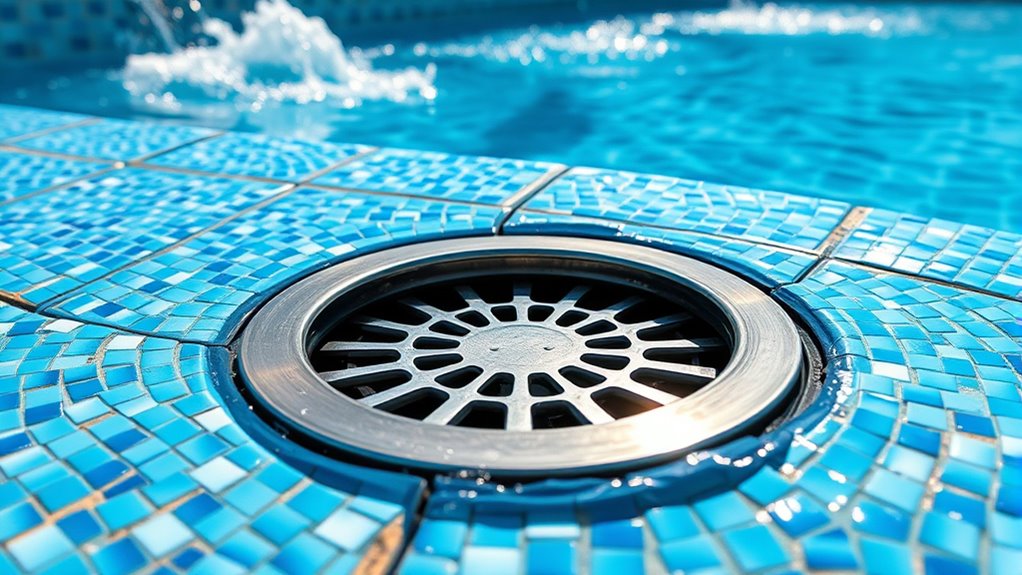
You should be aware that unprotected drain covers and complex plumbing setups increase the risk of entrapment. These features can make it harder to identify hazards or respond quickly if an issue arises. Recognizing these high-risk elements helps you take steps to keep everyone safe. Incorporating proper filtration systems can also reduce potential hazards associated with debris buildup or plumbing failures.
Unprotected Drain Covers
Unprotected drain covers pose a significant safety risk in pools and spas, especially at high-risk features like shallow areas, hot tubs, or decorative water features. These covers can easily be dislodged or damaged, exposing the powerful suction beneath. You should watch for:
- Loose or cracked covers that aren’t securely fastened.
- Missing covers in shallow or decorative sections where people often swim.
- Inadequate covers that don’t meet safety standards, increasing entrapment risks.
- Regular inspections enhance safety to guarantee covers stay in place and are in good condition. Replacing worn or damaged covers immediately can prevent accidents and save lives.
Complex Plumbing Configurations
Complex plumbing configurations often present high-risk features in pools and spas because their intricate designs can conceal dangerous suction points. These setups may include multiple pipes, valves, and fittings that create hidden zones where suction can trap a person’s body or hair. If you’re inspecting or maintaining a pool or spa, pay close attention to areas where pipes converge or where equipment is densely packed. Sometimes, these configurations hide unprotected or improperly installed drain covers, increasing the risk of entrapment. Recognizing these high-risk features helps you identify potential dangers before someone gets hurt. Always follow safety standards and ensure that all drain and plumbing components are compliant with current regulations to reduce entrapment hazards. Proper color accuracy and attention to detail in plumbing design can also help prevent overlooked hazards.
Safety Devices That Can Prevent Entrapment
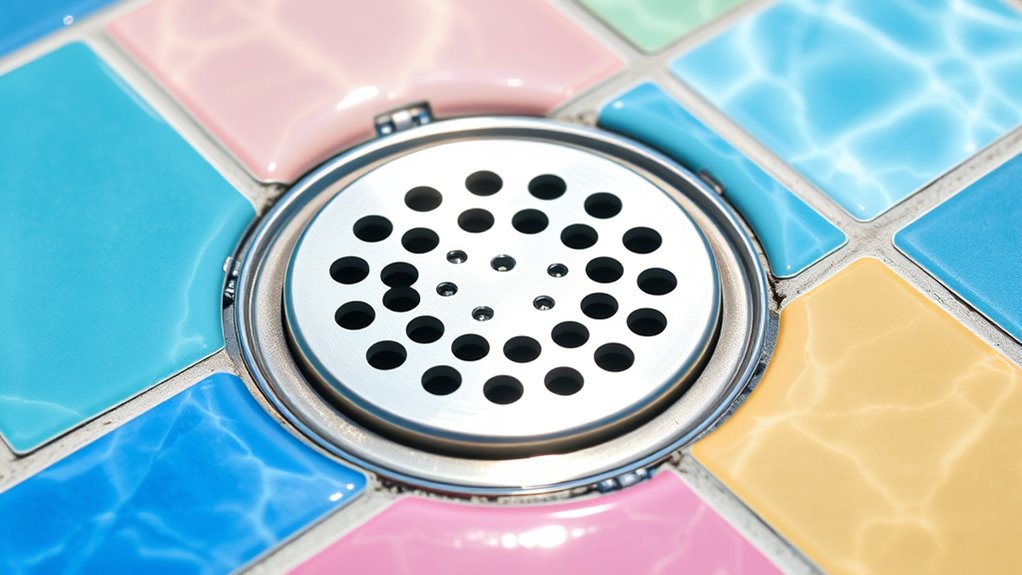
Implementing effective safety devices is crucial for preventing drain entrapment incidents. These devices create a safer swimming environment and reduce risks. First, you should install a U-shaped or spider grate over the drain to prevent hair, jewelry, or body parts from being pulled in. Second, consider adding an automatic shut-off system that activates if excessive suction is detected, stopping the pump immediately. Third, installing an safety vacuum release system (SVRS) allows water to escape if a person becomes trapped, reducing suction force. These devices work together to minimize entrapment risks and protect swimmers. Regularly ensuring these safety features are properly installed and functioning is essential for a safer pool experience. Be proactive and prioritize safety to prevent potential tragedies.
Additionally, understanding the industrial juice manufacturing process can help highlight the importance of safety and quality control measures in production environments.
How to Properly Maintain and Inspect Pool Drains

Regularly inspecting and maintaining your pool drains is essential to guarantee they function safely and effectively. Start by checking for cracks, chips, or damage to the drain cover, and replace it immediately if you find any issues. Ensure the cover is securely fastened and flush with the pool surface to prevent entrapment risks. Clean out debris, hair, and dirt around the drain area to prevent blockages that can affect water flow. Test the drain’s suction and flow periodically to confirm it’s working properly. Also, verify that all safety devices, like covers and vent systems, are intact and in good condition. Maintaining proper drain system performance is crucial for safety, and consistent maintenance reduces the chance of malfunctions, keeps your pool safe, and prolongs the lifespan of your drain system.
Tips for Educating Family and Friends About Pool Safety
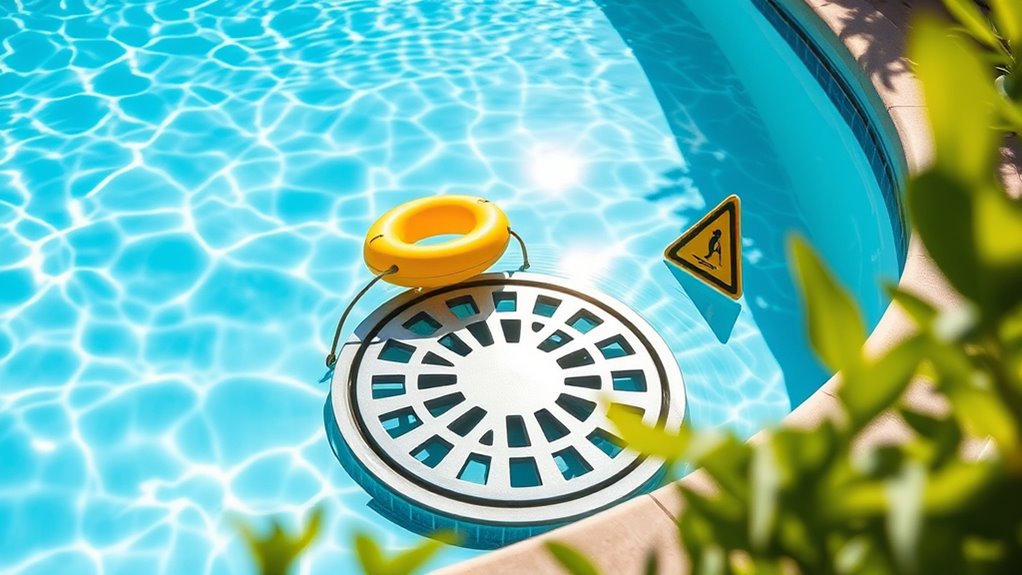
Educating your family and friends about pool safety is essential to prevent accidents and guarantee everyone enjoys the water responsibly. Start by sharing simple, clear rules to follow, such as never swimming alone, avoiding rough play, and keeping an eye on children at all times. Next, demonstrate the importance of recognizing hazards like damaged drains or missing covers, so they understand what to look for. Finally, encourage open communication—make sure everyone feels comfortable asking questions or voicing concerns about safety. You can also provide resources or quick safety tips to reinforce learning. Remember, the more informed and aware everyone is, the safer your pool environment becomes, reducing the risk of drain entrapment and other accidents. Additionally, understanding the noise levels of modern heat pumps can help ensure the outdoor equipment does not contribute to an unsafe or uncomfortable environment near your pool area.
The Role of Legal Standards and Regulations

Legal standards and regulations set the minimum safety requirements for pools to prevent drain entrapment incidents. You need to comprehend what compliance entails and how enforcement guarantees these rules are followed. Penalties for violations help hold pool owners accountable and promote safer environments.
Regulatory Compliance Necessities
Understanding and adhering to legal standards and regulations is essential for ensuring safety during drain entrapment rescue operations. These regulations set clear guidelines to protect both rescuers and victims. To stay compliant, you should:
- Familiarize yourself with local and national safety codes specific to pool and drain systems.
- Implement required safety measures, such as proper signage, barriers, and emergency shutoffs.
- Regularly train staff on updated regulations and best practices for rescue scenarios.
Standards Enforcement and Penalties
Enforcing standards and imposing penalties guarantees that safety regulations are taken seriously and consistently followed. When authorities actively monitor compliance, you’re more likely to prioritize proper drain safety measures. Penalties—fines, licenses suspension, or legal action—serve as strong deterrents against negligence or shortcuts. Clear standards set expectations for drain design, maintenance, and safety features, giving you a concrete framework to follow. If violations occur, swift enforcement ensures accountability and prevents future hazards. By adhering to these regulations, you protect yourself, your team, and the public from dangerous drain entrapment risks. Ultimately, strict enforcement and meaningful penalties motivate ongoing safety improvements, reducing accidents and saving lives. Staying compliant isn’t just about avoiding fines; it’s about safeguarding everyone around you. Recognizing the importance of regulatory compliance can further enhance safety standards and prevent preventable tragedies.
Emergency Response Steps If Someone Gets Entrapped
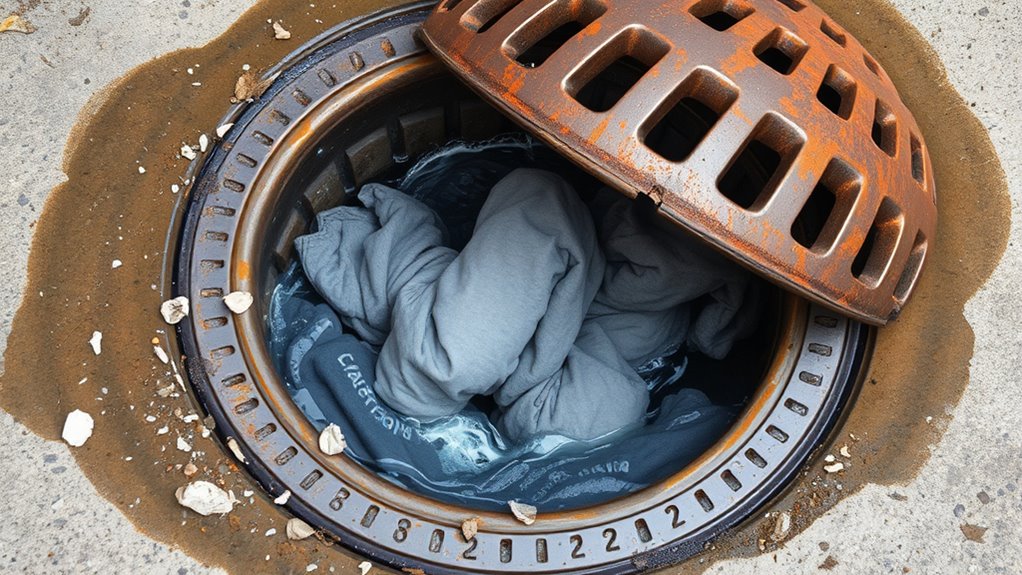
When someone becomes trapped in a drain, quick and coordinated action is crucial to prevent injury or further danger. Your first step is to stay calm and call emergency services immediately. While waiting for help, you can take these actions:
- Shut off the power to the pool or spa to prevent the drain from activating unexpectedly.
- Assist the victim by encouraging them to remain calm and avoid panicking.
- Use a rescue device like a safety hook or a towel to gently free them if it’s safe and you’re trained to do so.
Innovations in Pool Drain Design for Enhanced Safety
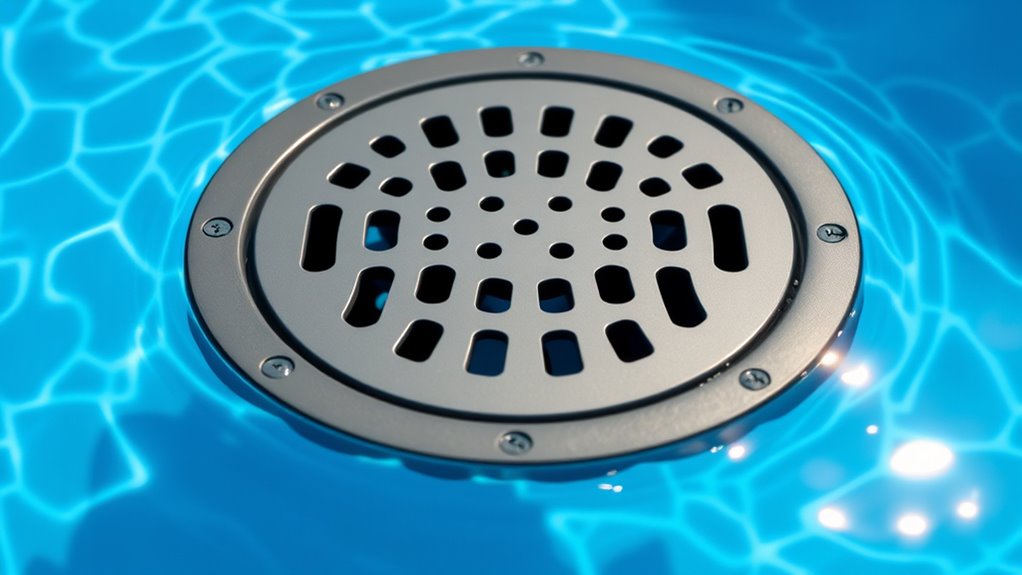
Recent advancements in pool drain design aim to markedly reduce the risk of entrapment incidents. Modern drain covers now feature non-grip surfaces and multiple outlets to prevent a single point of suction failure. Anti-entrapment systems like dual-drain setups and gravity drainage reduce the pressure that can trap a person’s hair or body. Some pools use covers with dome-shaped or flat designs that eliminate the powerful suction points. Regulatory standards, such as ASME/ANSI and CSA certifications, ensure these new designs meet safety criteria. You’ll notice these innovations in public pools and many residential pools, making the environment safer for swimmers. By choosing pools with updated drain systems, you’re actively reducing the risk of entrapment and creating a safer swimming experience.
Simple Steps to Make Your Pool Area Safer
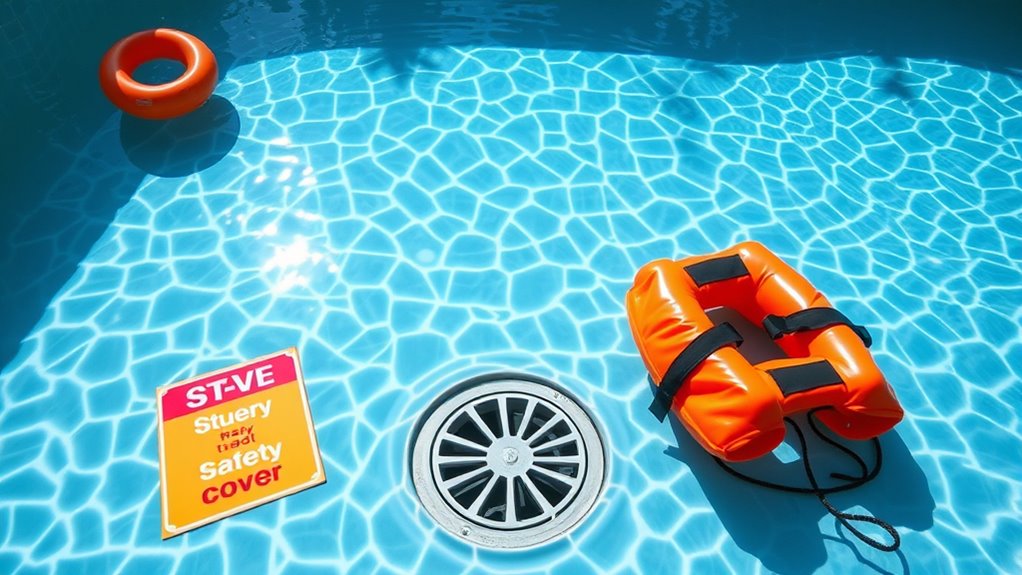
Making your pool area safer starts with simple, proactive steps that anyone can take. First, verify all drains have covers that meet safety standards to prevent entrapment. Second, keep a clear view of the entire pool area at all times, so you can quickly spot potential hazards or emergencies. Third, establish strict rules for everyone, especially children, like no diving in shallow areas or running around the pool. Regularly inspect and maintain drains, covers, and fencing to identify and fix safety issues promptly. By following these straightforward steps, you create a safer environment that minimizes risks and keeps everyone protected. Small, consistent actions make a big difference in preventing accidents and ensuring peace of mind around your pool.
Frequently Asked Questions
Are Children or Pets at Higher Risk of Drain Entrapment?
Children are at higher risk of drain entrapment because their smaller bodies can easily get caught in drain openings, and they often play near pools or drains without realizing the danger. Pets, especially small ones, are also vulnerable as they might swim or linger near drains, making it easier for them to become trapped. To protect both, always supervise kids and pets around drains and cover all openings securely.
How Often Should Pool Drains Be Inspected for Safety?
Think of your pool as a ticking time bomb if not checked regularly. You should inspect your pool drains at least once a month to make sure they’re secure and functioning properly. Look for cracks, loose covers, or any debris that could cause entrapment. Regular inspections help catch potential hazards early, preventing tragedy. Stay vigilant—your proactive approach keeps everyone safe and the water fun, not fear.
What Are the Legal Requirements for Pool Drain Safety?
You need to follow federal and state regulations, which often require compliant drain covers that meet ANSI/APSP standards and are properly installed. You must guarantee your pool has anti-entrapment devices and safety features, like dual drain covers or safety vacuum release systems. Regular inspections and maintenance are also mandatory to verify compliance. Stay updated on local laws, as they can vary, and always prioritize safety to prevent entrapment hazards.
Can DIY Safety Devices Effectively Prevent Entrapment?
DIY safety devices can help reduce entrapment risks but aren’t always reliable. Studies show that over 80% of drownings involve entrapment hazards, emphasizing the importance of proper safety measures. You might think homemade solutions are enough, but they often lack the strength and certification of commercial devices. For effective prevention, it’s better to install professionally tested covers and anti-entrapment systems that meet safety standards.
How Does Weather Affect Drain Entrapment Risks?
Weather considerably impacts drain entrapment risks. When it rains, water flow increases, making drains more active and potentially more dangerous. Flooded areas can obscure drain covers, leading to accidental entrapment. Cold weather can cause ice buildup around drains, creating slippery surfaces and hidden hazards. Hot, dry conditions may cause debris to clog drains, increasing the risk of accidents. Always stay vigilant and avoid swimming or playing near drains during adverse weather.
Conclusion
Think of your pool as a peaceful lake with hidden currents; a small unseen whirlpool can pose danger if you’re unaware. By understanding drain entrapment, using safety devices, and keeping up with maintenance, you create a safe harbor for everyone. Stay vigilant and proactive—your pool’s safety is like steering a boat clear of hidden rocks. With awareness, you turn potential hazards into calm waters, ensuring fun and safety for all swimmers.


